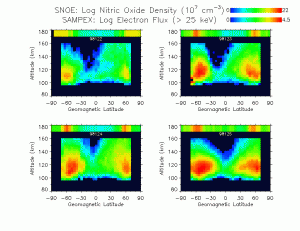Large Solar Disturbances and Their Geospace Consequences: SAMPEX, SNOE, and POLAR Correlative Observations
Coronal mass ejections (CMEs) are observed to have significant effects in near-Earth space. Fast CMEs in May, September, and October of 1998 had strong interplanetary shock waves ahead of large magnetic cloud structures. It is important from a Sun-Earth connections standpoint to understand magnetospheric and atmospheric responses to CME/cloud events. The 1998 CME events were first observed by SOHO sensors and they subsequently produced intense geomagnetic storms at Earth. The events in early May and in late October were seen by ACE sensors to be co-mingled with solar wind streams. The result was very pronounced substorm events, intense relativistic electron enhancements, and massive buildups of nitric oxide (NO) in the upper atmosphere. We use the PIXIE instrument onboard POLAR to obtain global views of 2-12 keV x-rays impacting the upper atmosphere. This gives a good measure of relatively low-energy electron precipitation into the atmosphere. The LICA sensor onboard SAMPEX measures E>25keV electrons in a high-inclination, low-altitude orbit and gives a direct in situ measurement of medium-energy precipitating electrons. Finally, the Student Nitric Oxide Explorer (SNOE) spacecraft measures the NO production in the lower thermosphere.
We have compared the production of NO with the spatial extent and time variability of energetic electron inputs to the atmosphere. The combination of available space platforms allows us to trace disturbances from the sun to the atmosphere and to assess quantitatively the energy transport throughout the Sun-Earth system during major events. The associated figure (see below), for example, shows a comparison of the energetic electron precipitation measured by the LICA sensor on SAMPEX with the nitric oxide measured by SNOE for four days in May 1998 during the great geomagnetic storm that occurred early in the month. There is a good correlation between the intensity of precipitating electrons and auroral zone NO production during this storm. Such results are key for understanding magnetosphere-atmosphere coupling.
Contributed by Dan Baker, LASP, University of Colorado
(Major parts of this work have been done by Charles Barth and Ken Mankoff (both at CU/LASP), by S. G. Kanekal and G. Mason (both at U. of Maryland), and by S. Petrinec (at Lockheed Martin/Palo Alto).

